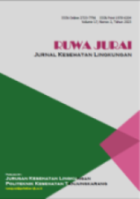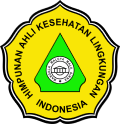Spatial Temporal Analysis of Groundwater Fluoride Concentration and Its Implication to Human Health in Jakarta, Indonesia
DOI:
https://doi.org/10.26630/rj.v19i1.4565Keywords:
Groundwater, Fluoride, Dental caries, JakartaAbstract
Groundwater serves as the primary source of potable water globally, including in Indonesia. Unfortunately, the presence of fluoride concentrations in groundwater, whether in ideal, insufficient, or excessive quantities, can have either beneficial or detrimental effects. Presently, the inhabitants of Jakarta persist in relying on groundwater as their primary source of clean water, which presents an escalating peril to public well-being as a result of increased domestic activities. Regarding the situation, this research aims to analyze the temporal trends and spatial distribution of fluoride concentration in groundwater and its potential consequences for public health risks in Jakarta. A total of 1,418 fluoride and temperature data from the Jakarta Environmental Agency was used for spatial-temporal analysis of 2016–2019 trends. We applied Microsoft Excel 2021 and ArcGIS Pro 3.2 for statistical and spatial data analysis. The result indicated that the fluoride concentration in groundwater was 72.14% below the minimum recommended value of 0.5 mg/L, mostly in the southern part of Jakarta. However, the average fluoride concentration for all seasons per year is consistently increasing, specifically in the northern part of Jakarta. Based on this research's findings, we concluded that the deficiency of fluoride concentration in groundwater is the majority problem in Southern Jakarta and could potentially cause dental caries if the groundwater is used as the daily source of clean water. This information is very useful for the government and public health authorities to further mitigate and protect people in Jakarta who still rely on groundwater as the source of clean water.
References
Ahmad, S., Singh, R., Arfin, T., & Neeti, K. (2022). Fluoride contamination, consequences and removal techniques in water: a review. Environmental Science: Advances, 1(5), 620–661. https://doi.org/10.1039/D1VA00039J
Ali, S., Thakur, S. K., Sarkar, A., & Shekhar, S. (2016). Worldwide contamination of water by fluoride. Environmental Chemistry Letters, 14(3), 291–315. https://doi.org/10.1007/s10311-016-0563-5
Ayenew, T. (2008). The distribution and hydrogeological controls of fluoride in the groundwater of central Ethiopian rift and adjacent highlands. Environmental Geology, 54(6), 1313–1324. https://doi.org/10.1007/s00254-007-0914-4
BPS-Statistics of DKI Jakarta Province. (2022). DKI Jakarta Province in Figures 2022 (1st ed.). BPS-Statistics of DKI Jakarta Province. https://jakarta.bps.go.id/id/publication/2022/02/25/5979600247867d861a1f334c/provinsi-dki-jakarta-dalam-angka-2022.html
Costa, D., Burlando, P., Priadi, C., & Shie-Yui, L. (2016). The nitrogen cycle in highly urbanized tropical regions and the effect of river–aquifer interactions: The case of Jakarta and the Ciliwung River. Journal of Contaminant Hydrology, 192, 87–100. https://doi.org/10.1016/j.jconhyd.2016.06.004
Edmunds, W. M., & Smedley, P. L. (2013). Fluoride in Natural Waters. In Essentials of Medical Geology (pp. 311–336). Springer Netherlands. https://doi.org/10.1007/978-94-007-4375-5_13
Gangani, N., Joshi, V. C., Sharma, S., & Bhattacharya, A. (2022). Fluoride contamination in water: Remediation strategies through membranes. Groundwater for Sustainable Development, 17, 100751. https://doi.org/10.1016/j.gsd.2022.100751
Indonesian Agency of Health Research and Development. (2018). Indonesia Basic Health Research Report. Indonesian Ministry of Health. https://repository.badankebijakan.kemkes.go.id/id/eprint/3514/1/Laporan Riskesdas 2018 Nasional.pdf
Indonesian Ministry of Health. (2023). Indonesian Ministry of Health Regulation No. 2 Year 2023. Indonesian Ministry of Health. https://peraturan.bpk.go.id/Details/245563/permenkes-no-2-tahun-2023
Jha, P. K., & Tripathi, P. (2021). Arsenic and fluoride contamination in groundwater: A review of global scenarios with special reference to India. Groundwater for Sustainable Development, 13, 100576. https://doi.org/10.1016/j.gsd.2021.100576
Kimambo, V., Bhattacharya, P., Mtalo, F., Mtamba, J., & Ahmad, A. (2019). Fluoride occurrence in groundwater systems at global scale and status of defluoridation – State of the art. Groundwater for Sustainable Development, 9, 100223. https://doi.org/10.1016/j.gsd.2019.100223
Kumar, P. S., Suganya, S., Srinivas, S., Priyadharshini, S., Karthika, M., Karishma Sri, R., Swetha, V., Naushad, M., & Lichtfouse, E. (2019). Treatment of fluoride-contaminated water. A review. Environmental Chemistry Letters, 17(4), 1707–1726. https://doi.org/10.1007/s10311-019-00906-9
Maathuis, H., Yong, R. N. Y., Adi, S. B., & Prawiradisastra, S. (1996). Development of groundwater management strategies in the coastal region of Jakarta, Indonesia : final report. https://api.semanticscholar.org/CorpusID:127448967
Mukherjee, I., & Singh, U. K. (2018). Groundwater fluoride contamination, probable release, and containment mechanisms: a review on Indian context. Environmental Geochemistry and Health, 40(6), 2259–2301. https://doi.org/10.1007/s10653-018-0096-x
Rasool, A., Farooqi, A., Xiao, T., Ali, W., Noor, S., Abiola, O., Ali, S., & Nasim, W. (2018). A review of global outlook on fluoride contamination in groundwater with prominence on the Pakistan current situation. Environmental Geochemistry and Health, 40(4), 1265–1281. https://doi.org/10.1007/s10653-017-0054-z
Selinus, O. (Ed.). (2013). Essentials of Medical Geology. Springer Netherlands. https://doi.org/10.1007/978-94-007-4375-5
Shaji, E., Sarath, K. V., Santosh, M., Krishnaprasad, P. K., Arya, B. K., & Babu, M. S. (2024). Fluoride contamination in groundwater: A global review of the status, processes, challenges, and remedial measures. Geoscience Frontiers, 15(2), 101734. https://doi.org/10.1016/j.gsf.2023.101734
World Health Organization. (2002). World Health Report 2002: Reducing Risks, Promoting Healthy Life (1st ed.). https://www.who.int/publications/i/item/9241562072
Yadav, M., Singh, G., & Jadeja, R. N. (2021). Fluoride Contamination in Groundwater, Impacts, and Their Potential Remediation Techniques. In Groundwater Geochemistry (pp. 22–41). Wiley. https://doi.org/10.1002/9781119709732.ch2
Yang, F., Jia, C., Yang, X., Yang, H., & Chang, W. (2022). Probabilistic potential health risk quantification, hydrochemistry, driving forces of groundwater nitrate and fluoride in a typical irrigation district, Northern China. Journal of Environmental Management, 323, 116171. https://doi.org/10.1016/j.jenvman.2022.116171
Downloads
Published
How to Cite
Issue
Section
License
Copyright (c) 2025 Ruwa Jurai: Jurnal Kesehatan Lingkungan

This work is licensed under a Creative Commons Attribution-NonCommercial 4.0 International License.

Ruwa Jurai: Jurnal Kesehatan Lingkungan is licensed under a Creative Commons Attribution-NonCommercial 4.0 International License.
Authors who publish with this journal agree to the following terms:
- Authors retain copyright and grant the journal right of first publication with the work simultaneously licensed under a Creative Commons Attribution-Non Commercial License that allows others to share the work with an acknowledgment of the work's authorship and initial publication in this journal.
- Authors are able to enter into separate, additional contractual arrangements for the non-exclusive distribution of the journal's published version of the work (e.g., post it to an institutional repository or publish it in a book), with an acknowledgment of its initial publication in this journal.
- Authors are permitted and encouraged to post their work online (e.g., in institutional repositories or on their website) prior to and during the submission process, as it can lead to productive exchanges, as well as earlier and greater citation of published work.









